

Barney is standing against one wall in a triangular room (we'll call it triangle ABC).

Barney walks to a different wall (e.g. wall AB) by moving parallel to the third wall ( in this case, wall BC) like this.

Once Barney gets to this wall he turns and walks to the third wall (BC) by moving parallel to wall AC. This process continues as Barney moves from one wall to the next by walking parallel to the third wall.

Question: Do you think that Barney will ever return to his starting point? Why do you think so?

If we continue constructing Barney's path we see that it does look like Barney returns to where he started. But how can we be sure? Let's prove it!
*Note that throughout this investigation the length of a segment AB is simply denoted AB*
Before we begin our proof, we must digress momentarily to investigate what occurs when you draw a line parallel to a base of a triangle which intersects the other 2 sides. First we'll begin with an arbitrary triangle. Then we'll draw the required line (parallel to the base and intersecting 2 sides of the triangle). Check it out below.
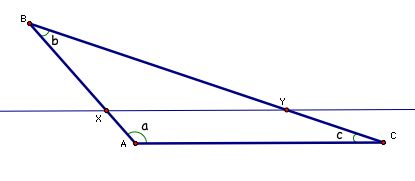
We know that line XY and line AC are parallel. By the corresponding angles theorem, this means that the measure of angle BXY equals the measure of angle BAC ('a' degrees). Similarly, the measure of angle BYX equals the measure of angle BCA ('c' degrees). We can fill in our picture with this information.
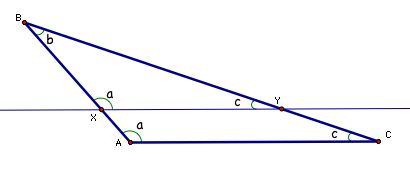
Since triangles BAC and BXY have the 3 pairs of congruent angles, triangle BAC is similar to triangle BXY. This means that the following proportional relationship is true:

This means that if a line is drawn parallel to the base of a triangle then it cuts the sides of a trianlge proportionally.
This relationship will be very useful in proving Barney returns to his starting position.
Let's look back at Barney's path (with each point where Barney reaches a wall being labeled).

We'll let D be Barney's starting point and D' be the point where Barney touches wall AC (the 6th wall touch). In order to prove that Barney gets back to the same point, we need to prove that D and D' are actually equal (the same point). Here we go . . .
Since Barney's starting point D is on side AC we know that the following:

Barney's path requires him to move from AC to AB in a path parallel to BC - he eventually lands at point E. From our previous digression we know that if a line is drawn parallel to the base of a triangle (in our case the base is side BC), then the sides of the triangle are cut proportionally. Thus the following must be true:


Next Barney moves from point E toward side BC along a line parallel to AC - and ends up at point F. Now AC has become our base and since EF if parallel to AC, we know that sides BA and BC are cut proportionally. Thus


Continuing, Barney's path from F to side AC (parallel to side AB=base) means sides BC and AC are cut proportionally as follows:


Now he moves from point G to side AB. As before we find that


Similary, when Barney travels from H to side BC, his path cuts AB and BC proportionally so that


Finally Barney travels from point I along a path parallel to AB to reach side AC (at the point D'). We know that BC/BI=n. Since the path (ID' is parallel to the base AB, we know that sides BC and AC are cut proportionally. Thus the following must be true:


Let's take a closer look at what's happening side AC
We know that AC/AD'=AC/AD. By cross multiplying we find that (AC)(AD)=(AC)(AD') which implies that AD=AD'. Since D and D' both lie on AC, this AD=AD' means that D=D'. Thus we see that Barney's starting point (D) is equal to his ending point (D'), that is he returns to the spot he began at!
Let's look back at our original room and starting point for Barney. In this case Barney reaches a wall 6 times before he returns to his starting point. Do you think that this is always true? Will the number of 'wall touches' change when Barney's starting position changes? Do the dimensions of the room affect Barney's path. Use this Geometer's Sketchpad file to explore these questions. You may want to change where Barney starts his path, or you may want to alter the sides of the triangle.
Question: What if Barney begins at a vertex?

Well, in order for Barney to move parallel to a side, he'll actually have to move along that side. So, if he starts at vertex A, he could move along side AB. Then when he got to vertex B he would have to walk along side BC. Finally, when he got to vertex C we would move along side AC until he reached his starting point, A. In this case, Barney's path actually has infinitely many 'wall touches.'
Question: What path do we see if Barney begins at the midpoint of one side?

If Barney begins at the midpoint and moves to side AB, his path must be parallel to side BC. If a line is drawn from the midpoint of one side (AC) to another side of the triangle (AB) and that line is parallel to the third side (BC), then that line intersects AB at its midpoint. This means that point P must be the midpoint of segment AB. Next Barney move from P, in a path parallel to AC, to get to point Q. By the same reasoning, Q must be the midpoint of BC. Then Barney travels from Q, the midpoint of BC, parallel to side AB until he gets to side AC. Again we see that the intersection point is the midpoint of side AC - exactly where Barney started! So we see that if Barney begins at the midpoint of a side, he only touches the wall three times before he returns to where he started.
Now let's change the situation a bit by extending the lines through the vertices of triangle ABC and now let Barney's starting point be outside of the triangle. The same walking rules will apply.
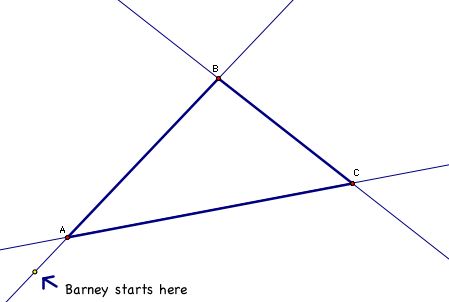
So Barney can walk in a path parallel to line BC until he reaches the third side (line AC). He'll continue walking according to these rules.
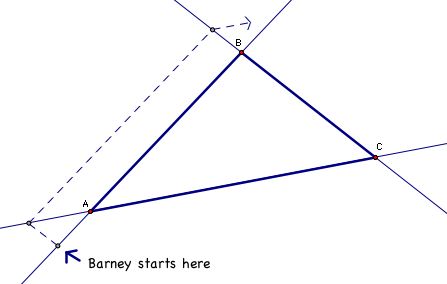
What do you think Barney's path will look like? Do you think that he will return to his starting point like before? Why?

So it does look like Barney gets back to his starting point. But how can we be sure? Let's prove it!
We will call Barney's start point D. We will denote AB/AD = n where n is a real number.
Barney begins as point D and moves parallel to side BC toward line AC. We'll call the point on line AC where he lands E. In our diagram we now have triangles ABC and ADE to investigate. By the vertical angles theorem we know that the measure of angle BAC equals the measure of angle DAE which is 'a' degrees. Since DE is parallel to BC and EC is a transversal across these parallel lines, angle BCA is congruent to angle DEA ('c' degrees). Since we have 2 pairs of congruent angles, we know triangle ADE is similar to triangle ABE.

Since triangle ADE is similar to triangle ABC, we know that corresponding sides are proportional. Thus AB/AD=AC/AE. We know AB/AD= n , so it must be the case that AC/AE = n.
Now let's look at the second part of Barney's path. He moves from E toward line BC in a path parallel to AB and reaches point F. Let's examine triangle FEC and ABC. Since line EF is parallel to AB, by the corresponding angles theorem angle FEC is congruent to angle BAC ('a' degrees). Since both triangles also share angle BCA, we know that triangle FEC is similar to triangle BAC.
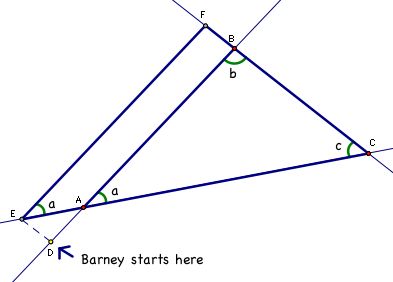
Therefore the ratio of corresponding sides of these two triangles is congruent. Thus CE/AC=CF/BC. We know CE=AC+AE and CF=BC+BF. Thus we find that (AC+AE)/AC=(BC+BF)/BC. By simplifying these fractions we see that 1+AE/AC=1+BF/BC which implies that AE/AC=BF/BC. From above we know that AC/AE = n. Therefore AE/AC=1/n=BF/BC. And thus BC/BF=n.
Barney continues this pattern and moves from F toward line AB and to reach point G. Now we can examine triangles BFC and ABC. By the vertical angles theorem we know that angle FBG is congruent to angle CBA ('b' degrees). Since segment FG is parallel to AC we know, by the corresponding angles theorem that angle BFG is congruent to angle BCA ('c' degrees). Since we know have two pairs of corresponding congruent angles, we know that triangle ABC is similar to triangle BFG.
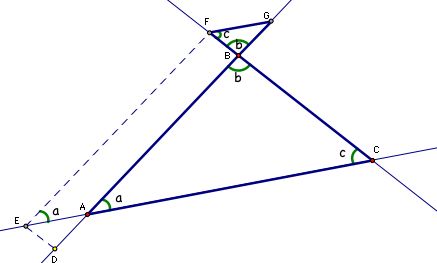
Therefore we know the following relationship is true: CB/BF=AB/BG. From above we know that CB/BF=n and thus AB/BG=n.
And so we repeat Barney's movement to form a portion of his path from G to H. Since segment GH is parallel to line BC, we know by the corresponding angles theorem that angle ABC is congruent to angle AGH ('b' degrees). Since triangles ABC and AGH both contain angle BAC and they have a pair of corresponding congruent angles, we know that triangle ABC is similar to triangle AGH.
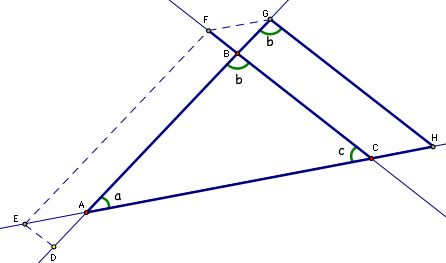
Therefore we know that the ratio of corresponding sides are equal. So AG/AB=AH/AC. From our diagram above we see that AG=AB+BG and AH=AC+CH. By substituting this into our equation we find that (AB+BG)/AB=(AC+CH)/AC. By simplifying our fractions we see that 1+BG/AB=1+CH/AC which implies that BG/AB=CH/AC. From our work above we know that AB/BG=n which means BG/AB=1/n and CH/AC=1/n. Therefore AC/CH=n.
Next Barney moves to point I following the prescribed walking 'rules.' By the vertical angles theorem we know that angle BCA is congruent to angle ICH ('c' degrees). Since segment HI is parallel to line AB, we know by the alternate angles theorem that angle ABC is congruent to angle HIC ('b' degrees). Now we can see that triangle ABC is similar to triangle HIC.
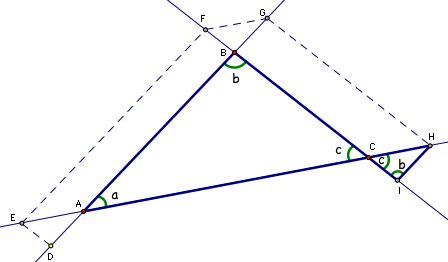
Therefore we know that AC/CH=BC/CI. From above we know that AC/CH=n and therefore BC/CI=n.
Finally Barney walks from I to his finishing point D' (a point on line AB). *Note that if we can prove that D'=D then we know Barney landed at his starting point* Since segment ID' is parallel to line AC, we know by the corresponding angles theorem that angles BCA is congruent to angle BID' ('c' degrees). Since triangles ABC and BID' both share angle ABC and also have a pair of corresponding congruent angles, we know triangle ABC is similar to triangle BID'.
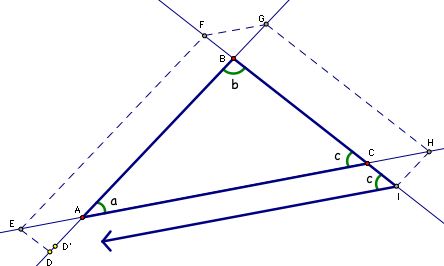
Therefore the following relationship must be true: BI/BC=BD'/BA. From our diagram we can see that BI=BC+CI and BD'=BA+AD'. Substituting this into our equation we find that (BC+CI)/BC=(BA+AD')/BA. By simplifying this we see that 1+CI/BC=1+AD'/BA which imples that CI/BC=AD'/BA. From above we know that BC/CI=n (meaning CI/BC=1/n). Thus we see that AD'/BA=1/n and BA/AD'=n.
At the beginning of this proof we noted that BA/AD=n. Since BA/AD'=n we know that BA/AD=BA/AD'. By cross multiplying we find that (BA)(AD')=(BA)(AD). This means that AD'=AD. Since both D and D' both lie on line AB (exterior to triangle ABC) it must be the case that D=D'. Which means . . . Barney did finish up where he started!